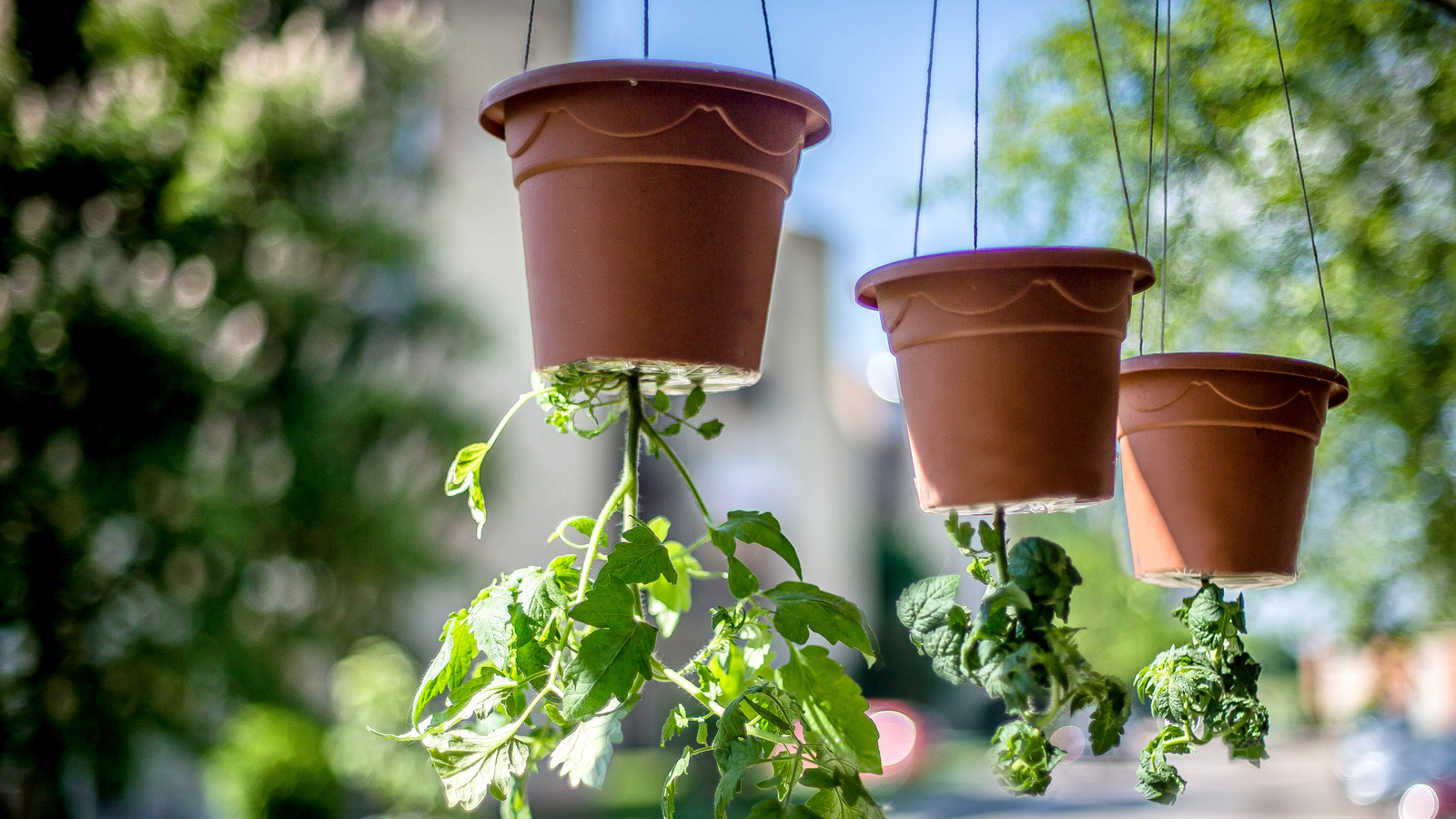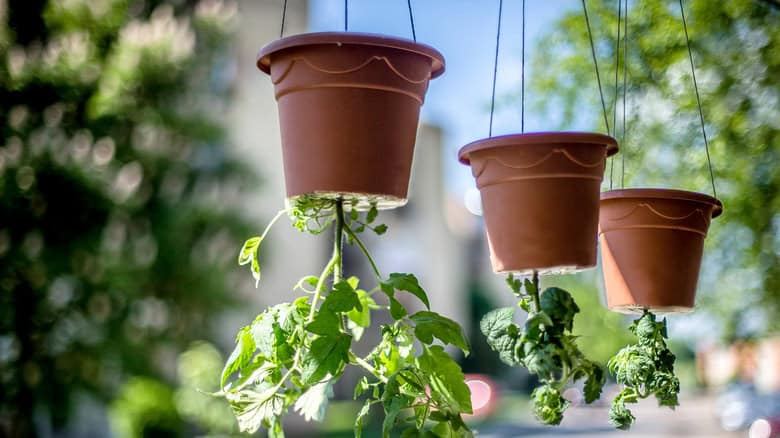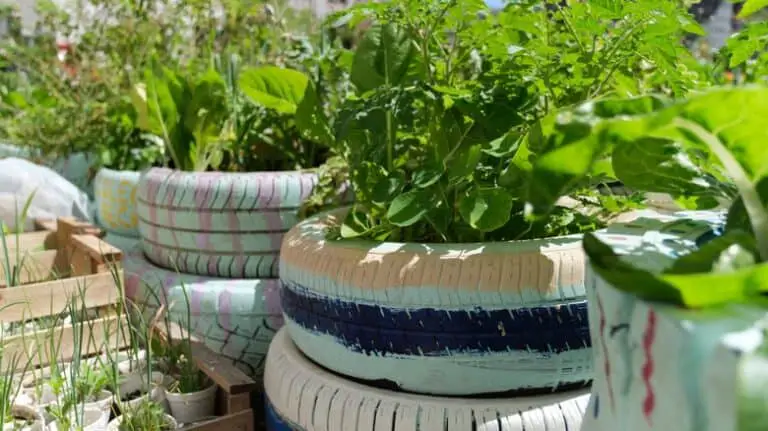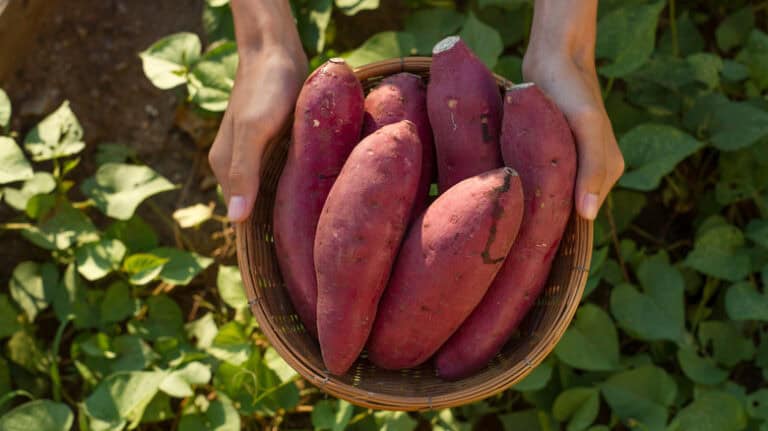Best Vegetables To Grow In Your Upside Down Garden: Top Picks
Tomatoes, cucumbers, and peppers are the best vegetables to grow in your upside down garden. These vegetables thrive well in such setups.
Growing vegetables in an upside down garden offers unique benefits. It saves space and minimizes the risk of pests. This method is ideal for urban gardeners with limited space. Tomatoes are popular for their high yield and ease of growth.
Cucumbers also flourish when grown upside down, producing crisp, refreshing fruits. Peppers, whether sweet or hot, adapt well to this unconventional method. Upside down gardening also reduces weeding efforts and soil-borne diseases. By choosing the right vegetables, you can enjoy fresh produce right from your balcony or small backyard.
Introduction To Upside Down Gardening
Upside down gardening is a unique way to grow vegetables. This method saves space and can be very fun. Instead of planting in the ground, plants grow hanging upside down. This helps plants get more sunlight and air.
Upside down gardening is perfect for small spaces. If you have a balcony or small yard, this is ideal. You can grow many types of vegetables upside down. It’s easy and can make your garden look cool.
Benefits Of Upside Down Gardening
- Space-saving: It uses vertical space, freeing up ground space.
- Better air circulation: Plants get more air, reducing disease.
- Easy harvesting: No bending needed to pick vegetables.
- Less weeding: Fewer weeds grow in hanging planters.
- Pest control: Fewer pests can reach the hanging plants.
How It Works
To start, choose a strong container. Make a hole at the bottom. Place a small plant through the hole. Fill the container with soil. Water the plant well.
Hang the container in a sunny spot. Make sure it gets at least 6 hours of sunlight. Water the plant regularly. Check it for pests and diseases. Enjoy watching your vegetables grow upside down.
| Vegetable | Best Growing Conditions |
|---|---|
| Tomatoes | Full sun, regular watering |
| Peppers | Warm weather, consistent moisture |
| Cucumbers | Warm weather, well-drained soil |
| Eggplants | Full sun, rich soil |
Tomatoes
Tomatoes are a favorite choice for upside-down gardens. They are easy to grow and produce delicious fruit. Growing tomatoes upside down saves space and reduces pests. Here is a guide on how to grow tomatoes in your upside-down garden.
Varieties Suitable For Upside Down
Not all tomato varieties are ideal for upside-down growing. Choose smaller, determinate types for best results. Here are some of the best varieties:
- Cherry Tomatoes: Small, sweet, and grow well upside down.
- Roma Tomatoes: Compact plants with a high yield.
- Patio Tomatoes: Specifically bred for container gardening.
- Better Bush: Sturdy and produces medium-sized fruit.
Planting Tips
Follow these tips to ensure your upside-down tomatoes thrive:
- Choose the Right Container: Use a sturdy container with good drainage.
- Use Quality Soil: Fill the container with nutrient-rich potting mix.
- Plant Seedlings: Insert the tomato seedling through the bottom hole.
- Secure the Plant: Add soil to hold the plant in place.
- Water Regularly: Keep the soil moist but not soggy.
- Fertilize: Use a balanced fertilizer every two weeks.
- Prune: Trim excess leaves to promote airflow and reduce disease.
By following these steps, you can enjoy a bountiful harvest of upside-down tomatoes.
Peppers
Growing peppers in an upside-down garden is a fantastic choice. Peppers thrive in this unique setup and produce vibrant, tasty fruits. This section covers the best types and their growth requirements.
Types Of Peppers
Different peppers can be grown upside down. Here are some popular choices:
- Bell Peppers: Sweet and crunchy, great for salads and cooking.
- Jalapeños: Mildly hot, perfect for adding a kick to dishes.
- Banana Peppers: Sweet and tangy, ideal for pickling and sandwiches.
- Habaneros: Extremely hot, for those who love spicy food.
Growth Requirements
Peppers need specific conditions to thrive:
| Requirement | Description |
|---|---|
| Sunlight | Peppers require at least 6-8 hours of direct sunlight daily. |
| Soil | Use well-draining soil rich in organic matter. |
| Watering | Water regularly, keeping the soil consistently moist but not soggy. |
| Temperature | Maintain temperatures between 70-85°F for optimal growth. |
| Fertilization | Use a balanced fertilizer every 2-3 weeks. |
By meeting these needs, your upside-down pepper garden will flourish.

Credit: gardenauntie.com
Cucumbers
Cucumbers are a great choice for your upside down garden. They are easy to grow and can yield a bountiful harvest. Growing cucumbers upside down saves space and keeps them away from pests and diseases. Let’s explore the best varieties and care instructions for growing cucumbers in your upside down garden.
Ideal Varieties
- Burpless Bush Hybrid: This variety is compact and perfect for small spaces.
- Spacemaster: Known for its short vines, it’s ideal for upside down growing.
- Salad Bush: Produces delicious, small cucumbers and thrives in containers.
Care Instructions
Planting: Start cucumber seeds indoors 2 weeks before the last frost. Use a high-quality potting mix and ensure the container has good drainage.
Watering: Water cucumbers regularly to keep the soil moist. Do not overwater as it can cause root rot.
Fertilizing: Use a balanced fertilizer every two weeks. This helps in the growth and production of cucumbers.
Pruning: Trim excess foliage to allow sunlight to reach the fruits. This prevents disease and promotes healthy growth.
Harvesting: Pick cucumbers when they are about 6-8 inches long. Regular harvesting encourages more fruit production.
| Task | Frequency |
|---|---|
| Watering | Every 2-3 days |
| Fertilizing | Every 2 weeks |
| Pruning | As needed |
| Harvesting | Regularly |
Eggplants
Eggplants are perfect for an upside-down garden. They grow well in small spaces. Their unique growth habit makes them ideal for hanging planters. Eggplants also add a touch of color to your garden.
Best Choices
Choosing the right eggplant variety is crucial. Here are some top picks:
- Black Beauty: A classic, large variety. Ideal for cooking.
- Fairy Tale: Small and striped. Great for grilling.
- Rosa Bianca: Italian heirloom. Sweet and creamy.
Maintenance Tips
Eggplants need regular care to thrive. Follow these tips for success:
- Watering: Keep soil moist but not soggy. Water regularly.
- Sunlight: Ensure 6-8 hours of sunlight daily.
- Fertilizing: Use a balanced fertilizer every two weeks.
- Pruning: Trim off yellow leaves and weak branches.
Here is a table summarizing the key maintenance tips:
| Maintenance Task | Details |
|---|---|
| Watering | Keep soil moist, avoid sogginess. |
| Sunlight | 6-8 hours daily. |
| Fertilizing | Every two weeks. |
| Pruning | Remove yellow leaves and weak branches. |
Eggplants can be a star in your upside-down garden. They are easy to grow and maintain.

Credit: www.housedigest.com
Beans
Beans are a fantastic choice for your upside-down garden. They are easy to grow and provide a bountiful harvest. Whether you prefer pole beans or bush beans, both thrive in this unique setup. Let’s dive into the specifics of growing beans upside down.
Pole Vs. Bush Beans
Pole beans and bush beans have distinct characteristics. Pole beans grow tall and need support. They produce beans over a long period. Bush beans are compact and do not require support. They yield all their beans at once.
| Type | Growth Habit | Harvest Time |
|---|---|---|
| Pole Beans | Climbing | Continuous |
| Bush Beans | Compact | All at once |
Supporting The Plants
Supporting your upside-down beans is crucial. Use a strong container and sturdy hooks.
- Choose a container with good drainage.
- Install hooks that can bear the weight of mature plants.
- Consider using a trellis for pole beans to climb.
Regularly check the support system for stability. Proper support ensures healthy growth and a good harvest.
By choosing the right type of beans and providing adequate support, you can enjoy a thriving upside-down garden.
Zucchini
Zucchini is a favorite in many gardens due to its versatility. Growing zucchini upside down can save space and reduce pest issues. This method also keeps the fruits clean and easy to harvest.
Varieties To Grow
Selecting the right zucchini variety is crucial for a successful upside-down garden. Here are some recommended varieties:
- Black Beauty: Known for its dark green skin and tender flesh.
- Golden Zucchini: Bright yellow color makes it easy to spot.
- Costata Romanesco: Has a nutty flavor and distinct ridges.
These varieties are productive and adapt well to upside-down growing conditions.
Pruning And Care
Proper pruning and care ensure healthy zucchini plants. Follow these steps:
- Check the soil moisture regularly. Zucchini needs consistent watering.
- Prune excess leaves to allow airflow and sunlight.
- Remove any dead or yellowing leaves promptly.
- Inspect plants for pests like aphids and squash bugs.
Fertilize the plants every two weeks with a balanced fertilizer. Support the vines if they become too heavy. This prevents breakage and ensures a good yield.
| Task | Frequency |
|---|---|
| Watering | Daily |
| Pruning | Weekly |
| Fertilizing | Bi-weekly |
These care practices will help your zucchini thrive in an upside-down garden.

Credit: www.pinterest.com
Herbs
Growing herbs in your upside down garden is a fantastic idea. Herbs are easy to grow and require minimal space. They provide fresh flavors for your cooking. Plus, they can thrive hanging upside down.
Top Herbs For Upside Down
Here are some of the best herbs to grow in an upside down garden:
- Basil – Basil loves sunlight and grows well upside down.
- Mint – Mint is hardy and spreads easily.
- Parsley – Parsley is resilient and grows well in small spaces.
- Thyme – Thyme is drought-resistant and does not need much water.
- Oregano – Oregano thrives in various conditions and is easy to care for.
Harvesting Techniques
Proper harvesting ensures your herbs stay healthy and productive. Follow these simple techniques:
- Use clean scissors to cut the herbs.
- Trim the herbs regularly to encourage new growth.
- Cut above the leaf node to promote branching.
- Harvest herbs in the morning for the best flavor.
- Dry or freeze the excess herbs to preserve them.
Growing herbs upside down is fun and rewarding. You get fresh, tasty herbs from your garden.
Tips For Success
Growing vegetables in an upside-down garden can be very rewarding. To achieve the best results, follow these tips for success. These guidelines will help your garden thrive.
Soil And Fertilizer
Choosing the right soil is crucial for your upside-down garden. Use a lightweight potting mix to ensure proper drainage. Heavy soil can cause root issues.
Add organic matter to your soil for better nutrient retention. Use compost or well-rotted manure for this purpose.
Fertilization is key to healthy plants. Use a balanced fertilizer, such as a 10-10-10 blend. Apply fertilizer every two weeks for the best results.
Here’s a quick table for easy reference:
| Soil Type | Fertilizer Type | Application Frequency |
|---|---|---|
| Lightweight Potting Mix | 10-10-10 Balanced Fertilizer | Every Two Weeks |
Common Issues And Solutions
Every garden faces challenges. Here are some common issues and their solutions.
- Root Rot: Ensure proper drainage to prevent waterlogging.
- Pest Infestations: Use natural pesticides or introduce beneficial insects.
- Nutrient Deficiency: Regularly fertilize and add organic matter to the soil.
Keep an eye on your plants for any signs of trouble. Quick action can save your garden.
Frequently Asked Questions
What Vegetables Grow Well Upside Down?
Tomatoes, peppers, and cucumbers thrive in upside down gardens. These vegetables benefit from improved air circulation and sunlight exposure.
How Do You Water An Upside Down Garden?
Water your upside down garden from the top. Ensure the soil stays consistently moist but avoid overwatering to prevent root rot.
Why Choose Upside Down Gardening?
Upside down gardening saves space and reduces pests. It allows for better air circulation and sunlight exposure, leading to healthier plants.
Conclusion
Growing vegetables in an upside-down garden is both fun and productive. Tomatoes, peppers, and cucumbers thrive in this setup. This method saves space and reduces pests. Enjoy fresh, homegrown produce with minimal effort. Start your upside-down garden today and reap the benefits of healthier, tastier vegetables.
Happy gardening!






